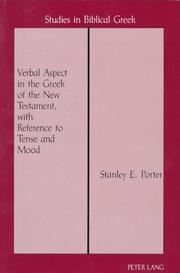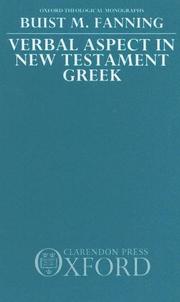| Listing 1 - 4 of 4 |
Sort by
|

ISSN: 08977828 ISBN: 0820424234 9780820424231 Year: 2003 Volume: 1 Publisher: New York (N.Y.) : Lang,
Abstract | Keywords | Export | Availability | Bookmark
 Loading...
Loading...Choose an application
- Reference Manager
- EndNote
- RefWorks (Direct export to RefWorks)
225.02*3 --- 225.02*3 Nieuw Testament: Griekse bijbelse filologie --- Nieuw Testament: Griekse bijbelse filologie --- Greek language, Biblical --- Aspect --- Tense --- Mood --- Verb --- Bible. --- Language, Style --- Bible. New Testament --- Language, style --- Greek language [Biblical ] --- Greek language, Biblical - Aspect --- Greek language, Biblical - Tense --- Greek language, Biblical - Mood --- Greek language, Biblical - Verb

ISBN: 0198267290 9780198267294 Year: 1990 Publisher: Oxford: Clarendon,
Abstract | Keywords | Export | Availability | Bookmark
 Loading...
Loading...Choose an application
- Reference Manager
- EndNote
- RefWorks (Direct export to RefWorks)
Greek language, Biblical --- Aspect. --- Bible. --- Language, Style. --- 225.02*3 --- -Biblical Greek --- New Testament Greek --- Nieuw Testament: Griekse bijbelse filologie --- Aspect --- -Nieuw Testament: Griekse bijbelse filologie --- 225.02*3 Nieuw Testament: Griekse bijbelse filologie --- -225.02*3 Nieuw Testament: Griekse bijbelse filologie --- Biblical Greek --- Ba-yon Tipan --- Bagong Tipan --- Jaji ma Hungi --- Kainē Diathēkē --- New Testament --- Nouveau Testament --- Novo Testamento --- Novum Testamentum --- Novyĭ Zavet --- Novyĭ Zavi︠e︡t Gospoda nashego Īisusa Khrista --- Novyĭ Zavit --- Nuevo Testamento --- Nuovo Testamento --- Nye Testamente --- Perjanjian Baru --- Dhamma sacʻ kyamʻʺ --- Injīl --- Greek language, Biblical - Aspect.
Book
ISBN: 9781433102998 1433102994 Year: 2008 Volume: 15 Publisher: New York: Lang,
Abstract | Keywords | Export | Availability | Bookmark
 Loading...
Loading...Choose an application
- Reference Manager
- EndNote
- RefWorks (Direct export to RefWorks)
Greek language, Biblical --- Verb. --- Aspect. --- Tense. --- Mood. --- Bible. --- Language, Style. --- 225.02*3 --- Nieuw Testament: Griekse bijbelse filologie --- Language, style. --- 225.02*3 Nieuw Testament: Griekse bijbelse filologie --- Biblical Greek --- New Testament Greek --- Aspect --- Mood --- Tense --- Verb --- Ba-yon Tipan --- Bagong Tipan --- Jaji ma Hungi --- Kainē Diathēkē --- New Testament --- Nouveau Testament --- Novo Testamento --- Novum Testamentum --- Novyĭ Zavet --- Novyĭ Zavi︠e︡t Gospoda nashego Īisusa Khrista --- Novyĭ Zavit --- Nuevo Testamento --- Nuovo Testamento --- Nye Testamente --- Perjanjian Baru --- Dhamma sacʻ kyamʻʺ --- Injīl --- Greek language, Biblical - Verb. --- Greek language, Biblical - Aspect. --- Greek language, Biblical - Tense. --- Greek language, Biblical - Mood.
Book
ISBN: 9004310886 9789004310889 9789004310872 9004310878 Year: 2016 Publisher: Leiden Brill
Abstract | Keywords | Export | Availability | Bookmark
 Loading...
Loading...Choose an application
- Reference Manager
- EndNote
- RefWorks (Direct export to RefWorks)
In Revisiting Aspect and Aktionsart, Francis G.H. Pang employs a corpus approach to analyze the relationship between Greek aspect and Aktionsart . Recent works have tried to predict the meanings that emerge when a certain set of clausal factors and lexical features combine with one of the grammatical aspects. Most of these works rely heavily on Zeno Vendler's telicity distinction. Based on empirical evidence, Pang argues that telicity and perfectivity are not related in a systematic manner in Koine Greek. As a corollary, Aktionsart should be considered an interpretive category, meaning that its different values emerge, not from the interaction of only one or two linguistic parameters, but from the process of interpreting language in context.
Greek language, Biblical --- Other minds (Theory of knowledge) --- Typology (Linguistics) --- Grammar, Comparative and general --- Language and languages --- Linguistic typology --- Linguistics --- Linguistic universals --- Minds of others (Theory of knowledge) --- Knowledge, Theory of --- Mind and body --- Biblical Greek --- New Testament Greek --- Aspect. --- Grammar. --- Religious aspects. --- Typology --- Classification --- Bible. --- Ba-yon Tipan --- Bagong Tipan --- Jaji ma Hungi --- Kainē Diathēkē --- New Testament --- Nouveau Testament --- Novo Testamento --- Novum Testamentum --- Novyĭ Zavet --- Novyĭ Zavi︠e︡t Gospoda nashego Īisusa Khrista --- Novyĭ Zavit --- Nuevo Testamento --- Nuovo Testamento --- Nye Testamente --- Perjanjian Baru --- Dhamma sacʻ kyamʻʺ --- Injīl --- Language, style. --- Greek language, Biblical - Aspect --- Greek language, Biblical - Verb --- Greek language, Biblical - Grammar --- Typology (Linguistics) - Religious aspects
| Listing 1 - 4 of 4 |
Sort by
|

 Search
Search Feedback
Feedback About UniCat
About UniCat  Help
Help News
News